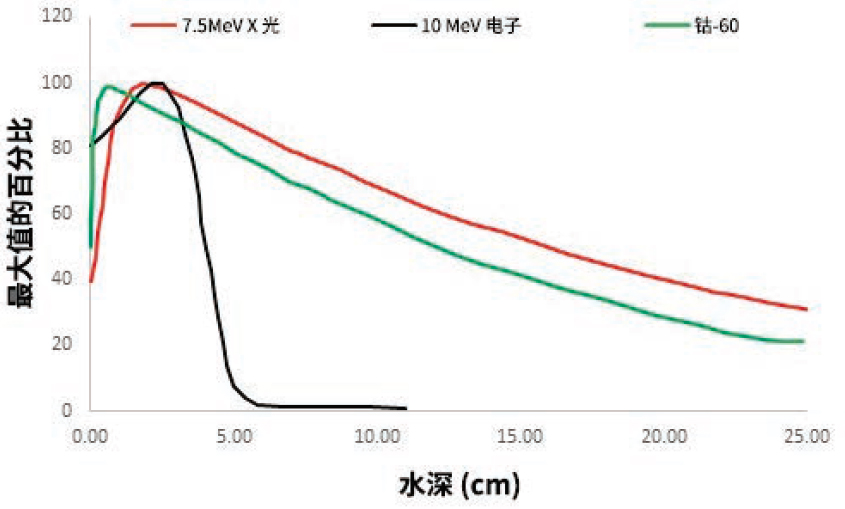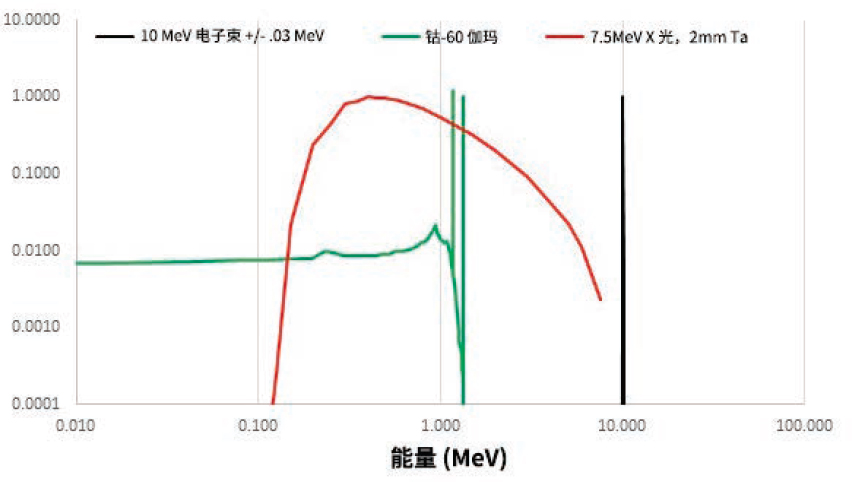附件 F
使用不同方式的辐射灭菌
使用伽马射线、X 射线和电子束(电子光束)的灭菌过程在能量转移和相互作用方面大致相似。伽马射线和 X 射线都涉及光子与材料相互作用的两步过程,主要是通过康普顿效应,然后产生的二次电子沉积剂量并对生物负载的生物结构造成损害。在电子束的情况下,光子与材料的初始相互作用被省略,取而代之的是电子直接与材料相互作用。也就是说,电子束是最直接的灭菌方式。电子束和伽马或 X 射线源之间的这种区别在于其导致产品中的不同剂量分布。
X 射线的穿透力略高于来自钴 60 的伽马射线(见图 F.1)。与伽马射线一样,X 射线会产生电子,这是与要消毒的产品相互作用时的活性因素。轫致辐射过程会产生用于灭菌的 X 射线。通常,7.5 MeV 电子被引导到致密的高 Z 材料上,例如钽。当电子被目标材料原子散射时,会产生广谱的 X 射线(见图 F.2)。轫致辐射过程在 7.5 MeV 时效率很低;只有 10-15% 的电子能量转换为 X 射线。其余的作为热量在目标中消散。因此,要产生 15 kW 的 X 射线功率,需要大约 120 kW 的电子束功率。一兆居里的钴 60 释放大约 15 kW 的光子能量。
用于灭菌的电子束加速器通常在 50 至 80 kW 范围内,相当于 3 至 5 MCi (111 至 185 GBq)的钴 60。电子束的剂量率可高达 20 MGy/hr,允许在数十秒内处理一盒或一箱产品。电子束装置的吞吐量可以设计为与伽马装置的吞吐量相当。
可能导致材料对三种辐射灭菌方式的响应不同的一个参数是剂量率。伽马装置通常提供大约 10 kGy/ hr。对于典型的灭菌处方 (25 kGy),这意味着设备必须在辐照室中保留 2.5-3 小时。X 射线系统的剂量率可能是伽马剂量率的六倍,因此照射时间为 20-30 分钟。电子束可以提供大约 20 MGy/hr 的速度,并且可以在几秒钟内照射这里的产品。这种剂量率变化可能是有利的,也可能是不利的,取决于被消毒的材料。材料中的一些不良反应可能没有时间在更高的剂量率下发生,从而提高其耐受辐射的能力。然而,水中 25 kGy 会导致温度升高 6°C。根据密度和其他几何因素的变化,这在产品的某些区域可能更高。短时间内温度急剧升高可能是一个问题,或者与在典型的钴 60 辐照器的高温环境中花费 2-3 小时相比,这可能更容易忍受。

备注:数据仅针对水 (1 g/cm3)。X 射线数据适用于轫致辐射靶上的 7.5 MeV 电子。
来源:Fermi National Accelerator Laboratory。

备注:电子束曲线包括 30 keV 的宽度,容易通过加速器源实现。然后将其光谱衰减 2 mm 的钽以表示韧致辐射目标中的自吸收。
来源:Fermi National Accelerator Laboratory。


